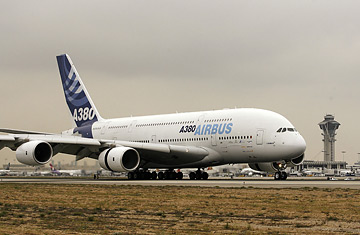
The Airbus A380, the world's largest airliner lands at Los Angeles International Airport .
It was like watching a killer whale launch itself with barely a splash completely out of the water. Instead of the usual roar of the engines, the airliner seemed to sigh, as if there were no tension in its wings, which support 811,000 lbs during the demonstration flight. Whoa, the whale can fly! And wait a sec, I'm on the whale.
Airbus had brought its problematic pride and joy to New York, part of a 12-day "route-proving" tour and I was along for the press preview. After a series of accelerated altitude climbs to get to an airspace directed by JFK airport flight control, the A380 cruised at 39,000 ft. At full capacity, holding 519 people, the plane would be 569 metric tons or 1.3 million lbs. And, in mid-flight, the wings would tilt up 12 feet to hold the load — looking not unlike the downward sweeping motion of a bird.
Most of the 197 people on board had already started mingling and moving about the double-decker cabin to discuss business matters and reactions to take-off. Others looked around, in and under the seats and overhead compartments and checked out the toilets (especially the one with the window and faux-marble lid in first class) as the crew prepared champagne, orange juice, fruit and hors d'oeuvres. Those still in their seats tested the goods: the channels and games on the touchscreen and the reclining capability.
The Airbus configuration of seats (which can be customized by airlines) put 12 first class seats and 307 economy seats on the first deck, and 63 business class seats and 137 economy on the upper deck — all distinguished by different pastel colored upholstery. In any other circumstance the scene would have been a flight attendant's nightmare with so many people moving about but, of course, the demonstration flight meant that people had free range to get a better sense of the craft — and who else was riding it.
Airbus and Lufthansa, the manufacturer and close client, had picked JFK's Hangar 19 to launch the plane in New York. It was also the spot where Pan Am had begun the maiden voyage of the Boeing 747 in 1970. And it is in Boeing's shadow that the A380 flies. It hasn't helped Airbus that the $300 million plane was two years late to its own party. Airbus suffered a terrible financial year due to A380 production delays, costing it an estimated $6.61 billion in forecast profit. The company also plans to cut 10,000 jobs. It estimates that it will take sales of more than 250 A380s to break even on its $14 billion investment.
But Airbus remains optimistic. "We fully expect to break even and sell 1,600 over the next 20 years," says Clay McConnell, Vice-President of Airbus communications. "We'll hit better than 50% of the market [over that time]." Singapore will be the first to fly commercially, receiving their first of a 19 plane-order this October. Other airlines include: Qantas, for 20; Air France, for 10; Virgin Atlantic, for 6; Thai Airways, for 6; and Korean Airlines, for 5. Emirates takes the cake for an order of 43. But most planes won't be delivered until 2009.
Conspicuously absent from the A380 order list are casth-strapped U.S.-based airlines which are more interested in Airbus' rival: Boeing. The B-787 Dreamliner is a smaller fuel-efficient jet just shy of 300-seat capacity. Already 38 airlines have ordered 490 planes ranging in price from $148 million to about $189 million. Continental, the first to sign on, has an order out for 25. Qantas has committed to 45 with 20 options, and the right to purchase 50 more. Airbus wants its A350 (still in development and listed at $165 million) to compete head-to-head with the certification and delivery of the B-787s in 2008. But ordering the A350 now means delivery in 2013. "The A350 will compete with the 787 in five years," says Airbus co-chief commercial officer John Leahy, "but Boeing has no competition for the A380." Compared to the average jumbo jet, the A380 has 30% less noise in the cabin and has 40% greater passenger capacity. It also consumes 20% less fuel.
After an hour in the air, the plane started its descent into JFK. It is one thing to see a whale fly but remember how all that weight splashes down? From the window, the airport runway seemed to approach rapidly. Then the tires hit the ground, causing a deep rumble. A split-second panic: would those little wheels give way? A few people winced as the aircraft shuddered and swayed and the A380 slowed down. The great white whale had landed.
